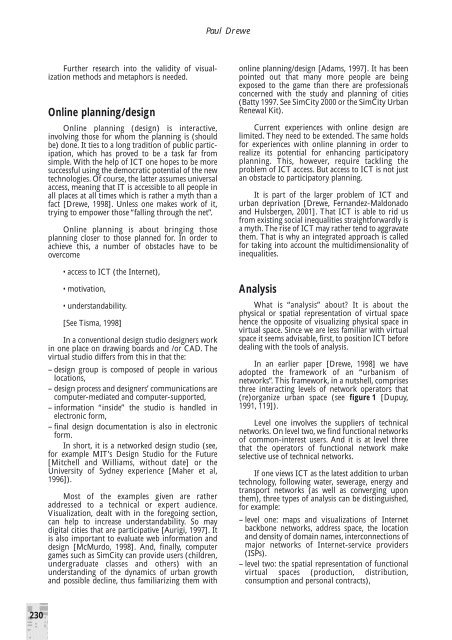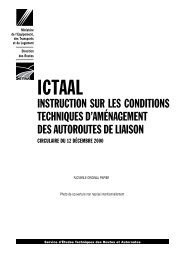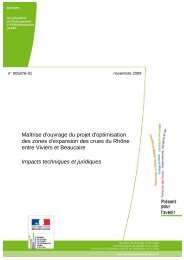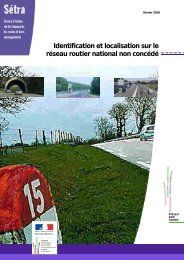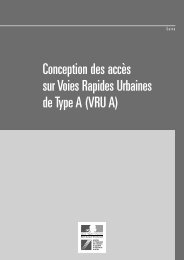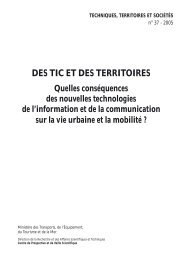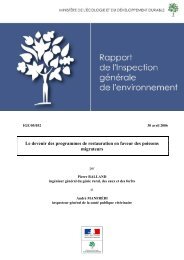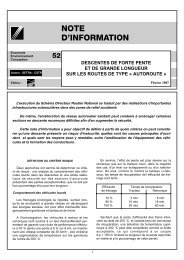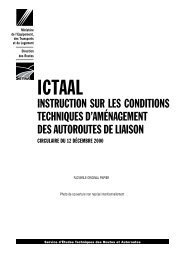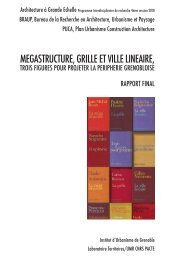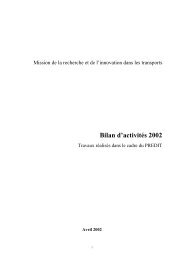Daniel Kaplan - Portail documentaire du Ministère de l'Ecologie
Daniel Kaplan - Portail documentaire du Ministère de l'Ecologie
Daniel Kaplan - Portail documentaire du Ministère de l'Ecologie
You also want an ePaper? Increase the reach of your titles
YUMPU automatically turns print PDFs into web optimized ePapers that Google loves.
230<br />
Further research into the validity of visualization<br />
methods and metaphors is nee<strong>de</strong>d.<br />
Online planning/<strong>de</strong>sign<br />
Online planning (<strong>de</strong>sign) is interactive,<br />
involving those for whom the planning is (should<br />
be) done. It ties to a long tradition of public participation,<br />
which has proved to be a task far from<br />
simple. With the help of ICT one hopes to be more<br />
successful using the <strong>de</strong>mocratic potential of the new<br />
technologies. Of course, the latter assumes universal<br />
access, meaning that IT is accessible to all people in<br />
all places at all times which is rather a myth than a<br />
fact [Drewe, 1998]. Unless one makes work of it,<br />
trying to empower those “falling through the net”.<br />
Online planning is about bringing those<br />
planning closer to those planned for. In or<strong>de</strong>r to<br />
achieve this, a number of obstacles have to be<br />
overcome<br />
• access to ICT (the Internet),<br />
• motivation,<br />
• un<strong>de</strong>rstandability.<br />
[See Tisma, 1998]<br />
In a conventional <strong>de</strong>sign studio <strong>de</strong>signers work<br />
in one place on drawing boards and /or CAD. The<br />
virtual studio differs from this in that the:<br />
– <strong>de</strong>sign group is composed of people in various<br />
locations,<br />
– <strong>de</strong>sign process and <strong>de</strong>signers’ communications are<br />
computer-mediated and computer-supported,<br />
– information “insi<strong>de</strong>” the studio is handled in<br />
electronic form,<br />
– final <strong>de</strong>sign documentation is also in electronic<br />
form.<br />
In short, it is a networked <strong>de</strong>sign studio (see,<br />
for example MIT’s Design Studio for the Future<br />
[Mitchell and Williams, without date] or the<br />
University of Sydney experience [Maher et al,<br />
1996]).<br />
Most of the examples given are rather<br />
addressed to a technical or expert audience.<br />
Visualization, <strong>de</strong>alt with in the foregoing section,<br />
can help to increase un<strong>de</strong>rstandability. So may<br />
digital cities that are participative [Aurigi, 1997]. It<br />
is also important to evaluate web information and<br />
<strong>de</strong>sign [McMurdo, 1998]. And, finally, computer<br />
games such as SimCity can provi<strong>de</strong> users (children,<br />
un<strong>de</strong>rgra<strong>du</strong>ate classes and others) with an<br />
un<strong>de</strong>rstanding of the dynamics of urban growth<br />
and possible <strong>de</strong>cline, thus familiarizing them with<br />
Paul Drewe<br />
online planning/<strong>de</strong>sign [Adams, 1997]. It has been<br />
pointed out that many more people are being<br />
exposed to the game than there are professionals<br />
concerned with the study and planning of cities<br />
(Batty 1997. See SimCity 2000 or the SimCity Urban<br />
Renewal Kit).<br />
Current experiences with online <strong>de</strong>sign are<br />
limited. They need to be exten<strong>de</strong>d. The same holds<br />
for experiences with online planning in or<strong>de</strong>r to<br />
realize its potential for enhancing participatory<br />
planning. This, however, require tackling the<br />
problem of ICT access. But access to ICT is not just<br />
an obstacle to participatory planning.<br />
It is part of the larger problem of ICT and<br />
urban <strong>de</strong>privation [Drewe, Fernan<strong>de</strong>z-Maldonado<br />
and Hulsbergen, 2001]. That ICT is able to rid us<br />
from existing social inequalities straightforwardly is<br />
a myth. The rise of ICT may rather tend to aggravate<br />
them. That is why an integrated approach is called<br />
for taking into account the multidimensionality of<br />
inequalities.<br />
Analysis<br />
What is “analysis” about? It is about the<br />
physical or spatial representation of virtual space<br />
hence the opposite of visualizing physical space in<br />
virtual space. Since we are less familiar with virtual<br />
space it seems advisable, first, to position ICT before<br />
<strong>de</strong>aling with the tools of analysis.<br />
In an earlier paper [Drewe, 1998] we have<br />
adopted the framework of an “urbanism of<br />
networks”. This framework, in a nutshell, comprises<br />
three interacting levels of network operators that<br />
(re)organize urban space (see figure 1 [Dupuy,<br />
1991, 119]).<br />
Level one involves the suppliers of technical<br />
networks. On level two, we find functional networks<br />
of common-interest users. And it is at level three<br />
that the operators of functional network make<br />
selective use of technical networks.<br />
If one views ICT as the latest addition to urban<br />
technology, following water, sewerage, energy and<br />
transport networks (as well as converging upon<br />
them), three types of analysis can be distinguished,<br />
for example:<br />
– level one: maps and visualizations of Internet<br />
backbone networks, address space, the location<br />
and <strong>de</strong>nsity of domain names, interconnections of<br />
major networks of Internet-service provi<strong>de</strong>rs<br />
(ISPs).<br />
– level two: the spatial representation of functional<br />
virtual spaces (pro<strong>du</strong>ction, distribution,<br />
consumption and personal contracts),


